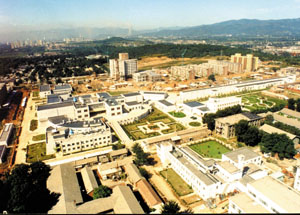
The lifetime of a modern electron-positron collider seems to span about a decade – witness LEP at CERN, commissioned in 1989 and now being decommissioned. At Beijing, the Beijing Electron Positron Collider (BEPC) was commissioned in 1988 and physicists are now considering the next step.
Beam energy at BEPC ranges from 1 to 2.8 GeV. The Beijing Spectrometer (BES) is the only detector with the major goal focused on tau-charm physics. Since data collection began in 1989, BES has collected large data samples of J/psi, psi´, Ds and tau particles.
Many important results have been obtained, including the precision measurement of the tau mass, decay properties of J/psi and psi´, and the observation of new decay channels of the x(2230). Recently, the cross-section scan between 2 and 5 GeV has provided key input to Standard Model consistency calculations, with significant impact on the prediction of the mass of Higgs.
During the 1999-2000 running period, more than 20 million J/psi hadronic events were collected in five months. Peak luminosity was 5 × 1030/cm2/s at a collision energy of 3.1 GeV. Many interesting new results will be published soon. As well as providing beams for particle physics, BEPC also provides synchrotron radiation light for many other research areas. Typically, the beam current is 130 mA at 2.2 GeV with a lifetime of 20-30 h.
There has been much discussion about the future of BEPC. There are two possibilities – construction of a new two-ring collider (tau-charm factory) with the luminosity increased by two orders of magnitude, or upgrade of BEPC (BEPC II) with the luminosity increased by one order of magnitude. The feasibility study on the tau-charm factory was carried out in 1995-1996.
Considering the latest developments of high-energy physics experiments and the successful running of B-factories, the best physics window for the future development of BEPC is foreseen as the charm sector, mainly in the J/psi and psi´ energy region, including searches for glueballs and quark-gluon hybrid particles, the study of light hadron spectroscopy, the J/psi family, and charmed and excited baryons. These studies are very important for the development of theoretical understanding.
BEPC has unique advantages for these physics topics, which cannot be covered by B-factories. Since the machine will run mainly on the J/psi and psi´ peaks, where the reaction rates are very high, BEPC II can provide enough statistics. BEPC II could be constructed at reasonable cost within a relatively short time.
Recently the Chinese Academy of Sciences chose the BEPC II option for the future development of BEPC, an upgrade of both the machine and the detector. The upgrade of the detector will improve its resolution to reduce systematic errors and to adapt to the higher event rate.
Achieving higher luminosity means squeezing the colliding beams more tightly together, reducing the bunch length and increasing the beam current. Some key technical modifications are under discussion, such as using a 500 MHz radiofrequency system and superconducting cavities, reducing the impedance of the vacuum chambers, installing a micro-beta quadrupole to further squeeze the beams, and using interlaced pretzel orbits for multiple bunches and bunch trains. The injection rate from the linac must also be increased by a factor of five with the full beam energy.
The upgrade of the BES detector currently foresees new barrel shower counters made of lead-scintillator fibres, new readout electronics, trigger and data acquisition system, new time-of-flight counters, new vertex chambers, etc.
The Chinese government supports the decision of the Chinese Academy of Sciences, and ratified the BEPC II project in principle in July. The Institute of High Energy Physics is working on the detailed BEPC II design, and will submit the proposal, including the budget and schedule, to the government soon.
BEPC was the outcome of close cooperation in the world high-energy physics community. BES is also an international collaboration, including many physicists from the US, the UK, Japan and Korea. Continuing international cooperation on the construction of both the machine and the detector of BEPC II is very important for its success, and Chinese physicists sincerely hope that the international community will continue its tradition.





